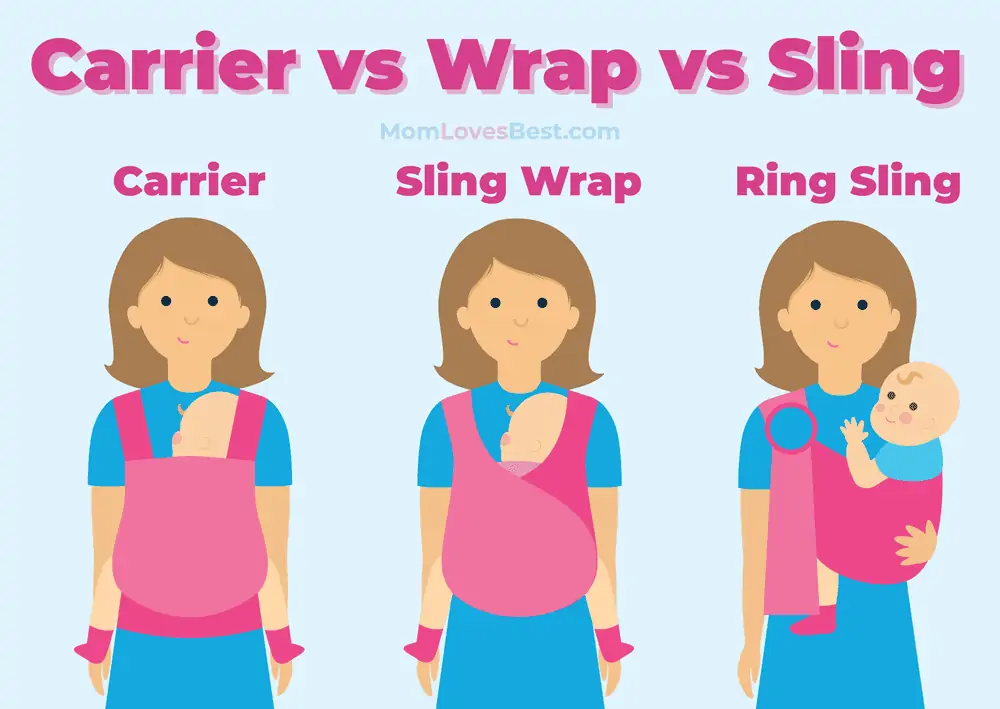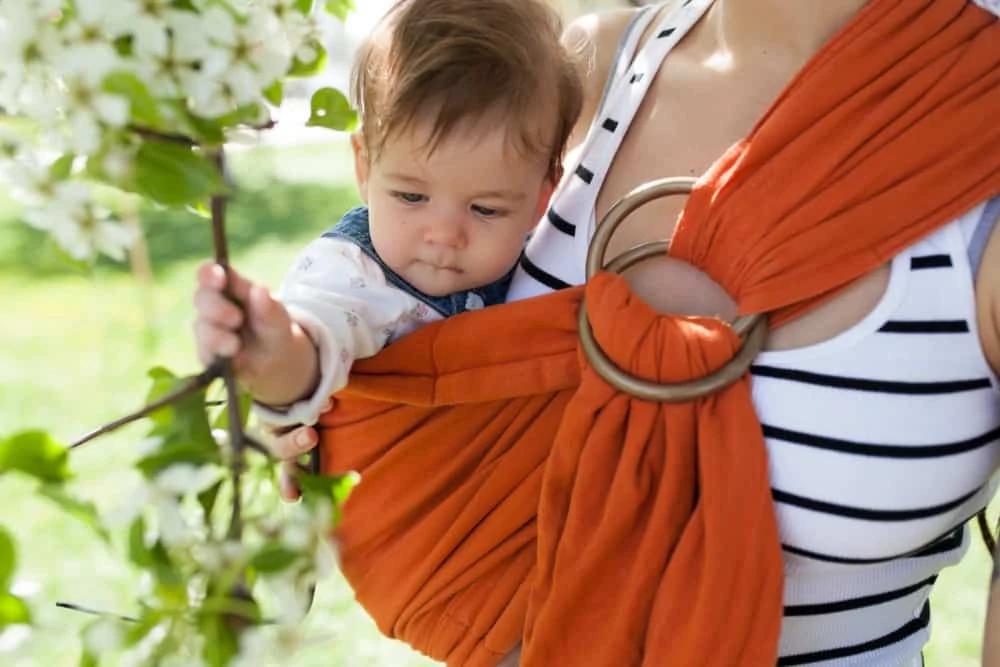Are you eager to start wearing your baby but feeling overwhelmed and intimidated by all the babywearing options?
You’re not alone! Most moms don’t know where to begin. With so many carrier designs on the market, it can be hard to know what style will be most comfortable for you and your baby.
Choosing the best option between carriers vs. wraps vs. slings can be nearly impossible if you don’t know the differences between them and what each style is designed for.
Having raised dozens of babies between us, our team has loads of babywearing experience! We want to share what we’ve learned with you because babywearing has so many amazing benefits.
We’ll discuss and compare three common babywearing options to help you decide on the perfect carrier for you.
Key Takeaways
- Soft-structured carriers are popular and easy to use, but can be expensive and may not provide adequate support for newborns.
- Baby wraps, either stretchy or woven, offer versatility and comfort but can have a steep learning curve.
- Ring slings are more affordable and easier to use than wraps but still require proper sizing and ring positioning for comfort.
- Consider your budget, baby’s age, and desired carrying positions when choosing a babywearing option.
Soft-Structured Carriers
A soft-structured baby carrier is the most common type of carrier and is what comes to mind when many people think of babywearing. It has buckles that attach around the parent’s waist and back to secure the baby in the carrier.
Soft-structured carriers come in a variety of brands and styles, and you can also purchase accessories such as chew pads and headcovers to go with them.
Why Use a Soft-Structured Carrier?
These carriers are easy to master, making them perfect for first-time parents. It is quick and easy to put your baby in and adjust as needed.
With this type of carrier, you can also carry your baby in several positions, and the padded straps make them comfortable. Many styles can hold your baby from newborn to toddler, and they are stable and durable.
Why They May Not Work for You
While soft-structured carriers might be an excellent choice for first-time parents, there are a few things to consider before you jump in. First, the better models tend to be expensive. They are also bulkier and hard to fit in a diaper bag.
Many soft-structured carriers do not provide adequate support for a newborn, meaning you will need to wait until your baby is older and has better head support before you can use it. Some parents also find the carrier’s buckles to be uncomfortable.
What You Should Know Before Buying
Before you buy a soft structured carrier, there are a few things you can do to make sure it is the right choice for you.
- Consider your budget. How much you’re willing to spend will go a long way in deciding the style and brand for you.
- Decide what positions you want to wear your baby in, and make sure you purchase a carrier that supports those positions.
- Consider your baby’s age. If they cannot support their neck on their own, you will need to make sure your baby carrier is adequately designed to support a newborn. This will keep your baby safe while wearing them.
Take Note
Baby Wraps
A baby wrap is a long piece of fabric you tie around your body to hold your baby. You can choose a stretchy wrap that is easier for beginners to master or a woven wrap that will hold your baby from newborn to preschool. The choices are limitless.
Why Should I Consider a Wrap?
Wraps are to the babywearing world what Von Dutch hats were to my high school — all the cool kids have them! But baby wraps can also be intimidating to try, especially for a parent new to babywearing. Still, don’t let fear hold you back because wraps can be a lot of fun.
Stretchy wraps come in a one-size-fits-all design and are easier to use because you can tie them on before putting your baby in the wrap.
Woven wraps are sturdy and comfortable for you and your baby as they provide enough support for you to wear your baby in many ways, including a back carry position. Plus, you can get them in a variety of fabrics, which means you can have different wraps for hot or cold weather to keep you and your baby comfortable.
Woven wraps also come in various sizes, so you can find one that works for you, no matter your size or your favorite wrap carrying position.
The Cons of Using a Wrap
Depending on which kind of wrap you choose, you will face a different set of cons.
A stretchy wrap, for example, does not offer a lot of support. It is best used in the newborn stage alone and cannot be used to back carry as it is not sturdy enough to ensure safety.
The lack of support in a stretchy wrap will also make it more uncomfortable as your baby grows because your baby’s weight will cause it to dig into your shoulders.
With woven wraps, the main issue is that they have a pretty steep learning curve. It can take quite a bit of time to master different wrapping techniques, and you will probably need to learn new wrap positions as your baby grows.
They are also not a one-size-fits-all solution. Your wrap size is based on your t-shirt size and varies slightly with different brands. Be sure to check the size chart before purchasing your wrap to ensure you get one that fits.
What To Know Before Buying
Before purchasing a wrap, consider how long you plan to use it. If you need a budget-friendly option for the first few months, a stretchy wrap is an excellent choice for you.
However, if you have an older baby or want a wrap for long-term use, a woven wrap is a better choice. It is also helpful to buy your wrap in-store because, at a store, you can try on different sizes. Some baby stores will even have certified babywearing technicians available to teach you a few wrap styles.
Ring Slings
If wraps intimidate you but you want something that offers more variety than a soft-structured carrier, a ring sling might be a choice to consider.
What Are the Benefits of Slings?
A sling is a piece of fabric you wrap around yourself that connects with a set of rings. Ring slings are also an affordable babywearing option popular with parents.
Slings are easier to use compared to wraps and aren’t as hot as soft-structured carriers in warm weather. You can also use them to wear your baby on your chest, hip, or back.
What Are the Cons of Slings?
The cons of a ring sling are similar to the disadvantages of a wrap. While they are easier to get used to than a wrap, there is still a learning curve. Slings also vary in size, so you’ll need to do your research before purchasing to make sure it fits properly.
You also need to pay attention to the ring positioning as you tie your sling. If not positioned properly, it can dig into your shoulder and cause irritation or bruising.
Can You Make Your Own Sling?
Would you like to use a ring sling but can’t decide on a brand? Well, with a little effort, you can make one yourself! It’s pretty simple, and you don’t even need sewing skills.
To make your ring sling:
- First, gather your supplies. You will need a woven wrap and a pair of rings. Use rings specifically made for ring slings so you know they will hold your baby’s weight.
- Fold one end of your wrap down. Fold it so the shorter tail goes all the way down your back but not fully around to your side.
- Take the shorter tail and begin to gather it at the fold, then pull it through both of your rings. Make sure that the wrap is straight and not twisted.
- Hold the wrap by the rings, grab the top rail, and wrap it around your back so the top rail is on the top of your shoulder and the shorter tail is folded closest to your back.
- Once the wrap is on your shoulder, you can secure it through the rings just as you would any store-bought ring sling.
















